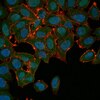Analysis of Histones H3 and H4 Reveals Novel and Conserved Post-Translational Modifications in Sugarcane.
Moraes, I; Yuan, ZF; Liu, S; Souza, GM; Garcia, BA; Casas-Mollano, JA
PloS one
10
e0134586
2015
Abstract anzeigen
Histones are the main structural components of the nucleosome, hence targets of many regulatory proteins that mediate processes involving changes in chromatin. The functional outcome of many pathways is "written" in the histones in the form of post-translational modifications that determine the final gene expression readout. As a result, modifications, alone or in combination, are important determinants of chromatin states. Histone modifications are accomplished by the addition of different chemical groups such as methyl, acetyl and phosphate. Thus, identifying and characterizing these modifications and the proteins related to them is the initial step to understanding the mechanisms of gene regulation and in the future may even provide tools for breeding programs. Several studies over the past years have contributed to increase our knowledge of epigenetic gene regulation in model organisms like Arabidopsis, yet this field remains relatively unexplored in crops. In this study we identified and initially characterized histones H3 and H4 in the monocot crop sugarcane. We discovered a number of histone genes by searching the sugarcane ESTs database. The proteins encoded correspond to canonical histones, and their variants. We also purified bulk histones and used them to map post-translational modifications in the histones H3 and H4 using mass spectrometry. Several modifications conserved in other plants, and also novel modified residues, were identified. In particular, we report O-acetylation of serine, threonine and tyrosine, a recently identified modification conserved in several eukaryotes. Additionally, the sub-nuclear localization of some well-studied modifications (i.e., H3K4me3, H3K9me2, H3K27me3, H3K9ac, H3T3ph) is described and compared to other plant species. To our knowledge, this is the first report of histones H3 and H4 as well as their post-translational modifications in sugarcane, and will provide a starting point for the study of chromatin regulation in this crop. | 26226299
 |















